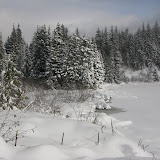
Wahkeena Creek

The hike from there was, as expected, a bit tricky. On the way up, we had to pass several sections of the trail that were completely frozen. Having traction devices and poles did help a bit though. As we were gaining elevation, there was more ice but still the water was running underneath. At some point we crossed a small stream that had only a couple of holes here and there were you could see water rushing.
Water under the ice

Strangely enough, once we got up to the basin, there was no snow or ice. It was like winter was not happening in a big are of the forest. Then we started descending the Multnomah creek and to the most interesting part of the hike. This loop can be done clockwise or counter clockwise. Although clockwise gives you a nice view of the waterfalls as you approach them, doing it counter clockwise as we were doing it, is more impressive as you approach the waterfalls from the top. As we were descending, the first waterfall was Ecola. It was partially frozen but still running. Then came Weisendanger, the big waterfall that I’ve captured many times before. This time though, the waterfall had a partial ice cover on one side. Despite the force and the amount of water coming down, it was incredible to see this veil of ice just barely holding on top of it. This scenery made the trip for me, it was just incredible.
Weisendanger Falls under the ice veil

Then we got another surprise. A much smaller fall (that I can’t find the name) was completely frozen. The interesting thing was you could actually see movement under the ice, so we knew water was running. The really cool thing was that, since it was completely covered, there was no sound at all. The waterfall was totally silent. From there it was just more downhill and more ice until we got back to Multnomah falls. By that time the weather was turning on us and it was starting to rain again. With temperatures near freezing, that meant freezing rain, so the drive home was not a lot of fun.



